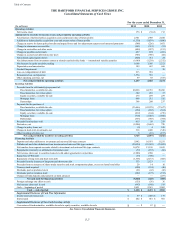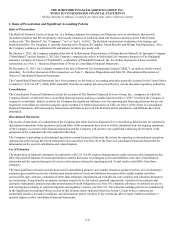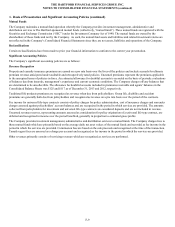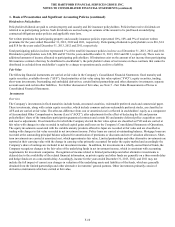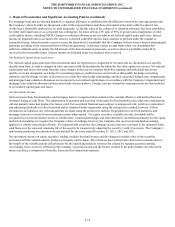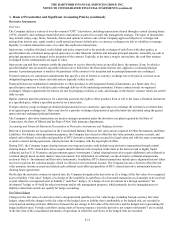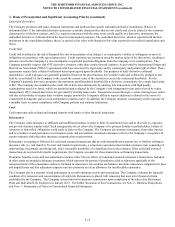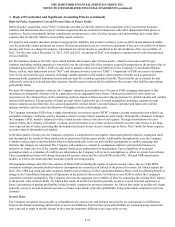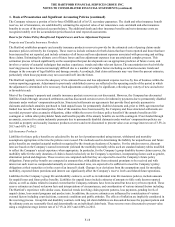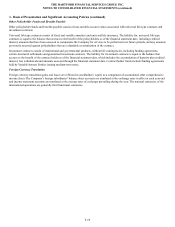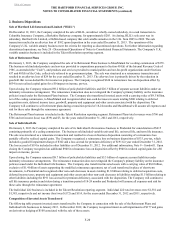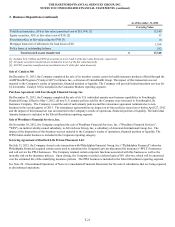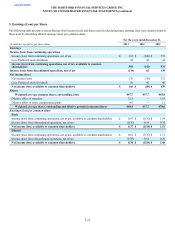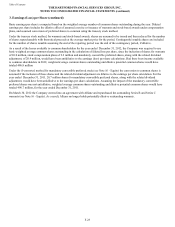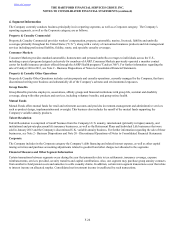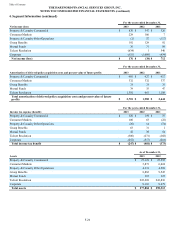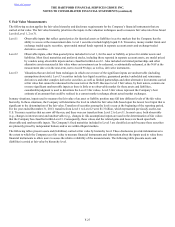The Hartford 2013 Annual Report Download - page 153
Download and view the complete annual report
Please find page 153 of the 2013 The Hartford annual report below. You can navigate through the pages in the report by either clicking on the pages listed below, or by using the keyword search tool below to find specific information within the annual report.THE HARTFORD FINANCIAL SERVICES GROUP, INC.
NOTES TO CONSOLIDATED FINANCIAL STATEMENTS (continued)
1. Basis of Presentation and Significant Accounting Policies (continued)
F-17
Goodwill
Goodwill represents the excess of costs over the fair value of net assets acquired. Goodwill is not amortized but is reviewed for
impairment at least annually or more frequently if events occur or circumstances change that would indicate that a triggering event for a
potential impairment has occurred. During the fourth quarter of 2011, the Company changed the date of its annual impairment test for all
reporting units to October 31st. As a result, all reporting units performed an impairment test on October 31, 2011 in addition to the
annual impairment tests performed on January 1st or October 1st, 2011, as applicable. The change was made to be consistent across all
reporting units and to more closely align the impairment testing date with the long-range planning and forecasting process. The
Company has determined that this change in accounting principle is preferable under the circumstances and does not result in any delay,
acceleration or avoidance of impairment. As it was impracticable to objectively determine projected cash flows and related valuation
estimates as of each October 31 for periods prior to October 31, 2011, without applying information that has been learned since those
periods, the Company has prospectively applied the change in the annual goodwill impairment testing date from October 31, 2011.
The goodwill impairment test follows a two-step process. In the first step, the fair value of a reporting unit is compared to its carrying
value. If the carrying value of a reporting unit exceeds its fair value, the second step of the impairment test is performed for purposes of
measuring the impairment. In the second step, the fair value of the reporting unit is allocated to all of the assets and liabilities of the
reporting unit to determine an implied goodwill value. If the carrying amount of the reporting unit’s goodwill exceeds the implied
goodwill value, an impairment loss is recognized in an amount equal to that excess.
Management’s determination of the fair value of each reporting unit incorporates multiple inputs into discounted cash flow calculations,
including assumptions that market participants would make in valuing the reporting unit. Assumptions include levels of economic
capital, future business growth, earnings projections and assets under management for certain reporting units and the weighted average
cost of capital used for purposes of discounting. Decreases in the amount of economic capital allocated to a reporting unit, decreases in
business growth, decreases in earnings projections and increases in the weighted average cost of capital will all cause a reporting unit’s
fair value to decrease.
Goodwill within Corporate is primarily attributed to the Company’s “buy-back” of Hartford Life, Inc. in 2000 and was allocated to each
of Hartford Life’s reporting units based on the reporting unit’s fair value of in-force business at the buy-back date. Although this
goodwill was allocated to each reporting unit, it is held in Corporate for segment reporting.
Property and Equipment
Property and equipment is carried at cost net of accumulated depreciation. Depreciation is based on the estimated useful lives of the
various classes of property and equipment and is determined principally on the straight-line method. Accumulated depreciation was $2.2
billion and $2.0 billion as of December 31, 2013 and 2012, respectively. Depreciation expense was $174, $183, and $216 for the years
ended December 31, 2013, 2012 and 2011, respectively.
Separate Accounts, Death Benefits and Other Insurance Benefit Features
The Company records the variable account value portion of variable annuity and variable life insurance products and institutional and
governmental investment contracts within separate accounts. Separate account assets are reported at fair value and separate account
liabilities are reported at amounts consistent with separate account assets. Investment income and gains and losses from those separate
account assets accrue directly to the policyholder, who assumes the related investment risk, and are offset by the related liability changes
reported in the same line item in the Consolidated Statements of Operations. The Company earns fees for investment management,
certain administrative expenses, and mortality and expense risks assumed which are reported in fee income.
Certain contracts classified as universal life-type include death and other insurance benefit features including GMDB and GMIB, offered
with variable annuity contracts. GMDBs and GMIBs have been written in various forms. These death and other insurance benefit
features require an additional liability be held above the account value liability representing the policyholders’ funds. This liability is
reported in reserve for future policy benefits in the Company’s Consolidated Balance Sheets. Changes in the death and other insurance
benefit reserves are recorded in benefits, losses and loss adjustment expenses in the Company’s Consolidated Statements of Operations.
The death and other insurance benefit liability is determined by estimating the expected present value of the benefits in excess of the
policyholder’s expected account value in proportion to the present value of total expected fees. The liability is accrued as actual fees are
earned. The expected present value of benefits and fees are generally derived from a set of stochastic scenarios, that have been calibrated
to our RTM separate account returns, and assumptions including market rates of return, volatility, discount rates, lapse rates and
mortality experience. Consistent with the Company’s policy on the Unlock, the Company regularly evaluates estimates used and adjusts
the additional liability balance, with a related charge or credit to benefits, losses and loss adjustment expense. For further information on
the Unlock, see the Deferred Policy Acquisition Costs and Present Value of Future Benefits accounting policy section within this
footnote.


